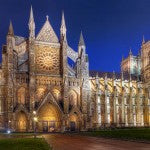Over time, Germanic influence spread throughout Western Europe. As the Dark Ages came to a close—fostering the way for the High Middle Ages—architecture changed once again from the Romanesque style, this time, definitely for the better, with the Gothic movement.
The Gothic movement started in France during the 12th century, when King Louis IX, a patron of arts, commissioned its spread throughout his kingdom. Visitors would flock France and marvel at the wondrous architectural pieces of work. From there, they would mimic such architecture and incorporate Gothic structures in their home countries.
Below are common features of Gothic structures:
Pointed arches
 Image source: Flickr
Image source: Flickr
Although primarily influenced by Teutonic culture, pointed arches were inspired by Persian architecture, as brought by the crusaders from the Middle-East. Pointed arches were notable in Europe since architects agreed that they were stronger.
Additionally, pointed arches helped Gothic churches attain their trademark height, as they allowed structures to be thinner, helping architects save money and add in more weight!
High towers, spires, and roofs
 Image source: Wikipedia
Image source: Wikipedia
Towers, spires, and roofs appeared to be soaring, almost piercing the skies. This adds to the grandeur of Gothic churches, as they were made for churchgoers to look up.
Improved lighting
Contrary to popular belief, Gothic churches were actually well-lit and weren’t gloomy on the inside. Windows and openings were strategically placed so that sunlight would enter and illuminate the whole church as efficiently as possible during that time.
Stained glass
 Image source: Cultural Travel Guide
Image source: Cultural Travel Guide
Stained glass images are very notable in Gothic churches. Images of Biblical figures, saints, and their deeds are often depicted in ornate and colorful stained glass illustrations. Stained glass images were important elements in Gothic art.
Flying buttresses
 Image source: Awesome Stories
Image source: Awesome Stories
Gothic buttresses soared high and were almost as tall as the structure itself. Apparently, the higher structures get, the more support they need. Flying buttresses were not only designed to hold the whole build up per se, but to also support the roofs.
Ribbed vault
 Image source: JennyMerr.wordpress.com
Image source: JennyMerr.wordpress.com
Although ribbed vaults can be found in Romanesque churches, Gothic structure featured stone ribs, which allows for more support. Arches of vaults were also pointed for the same reason that they would strengthen the structure—in this case, the ceilings.
Examples of Gothic Churches
Chartres Cathedral, France (1220 AD)
 Image source: Wikipedia
Image source: Wikipedia
Milan Cathedral, Italy (1386 AD)
 Image source: Wikipedia
Image source: Wikipedia
Reims Cathedral, France (1275 AD)
 Image source: Touropia
Image source: Touropia
Gothic architecture enjoyed its preeminence until the 16th century, where a cultural revolution stirred all throughout Europe. This event, called the Renaissance, was a result of the discovery of “lost” marvels of the ancient world. It also inspired artists and architects to base their works on ancient wonders, seemingly setting aside the Germanic style of Gothic architecture in favor of Greco-Roman aesthetics.
Architecture during the Renaissance era will be discussed in the next entry.


